Now that Pennsylvania has gone to the polls and voted (and seemingly validated my 85-73 prediction in favor of Clinton), I’ll be taking a stab at predicting the delegate allocation in North Carolina, the state that has the most delegates remaining. Looking at the polling average from the state, it’s obvious that Barack Obama has been leading in the polls by double digits over Hillary Clinton for some time now. While the most recent polls show some tightening – mostly as a result of Clinton gaining strength among white voters – Obama still holds a double-digit victory and should still win the state handily.
Below the fold, you’ll find by district-by-district breakdown of how I think the delegates will be allocated, accompanied with my commentary…
North Carolina (May 6th primary, 115 pledged delegates)
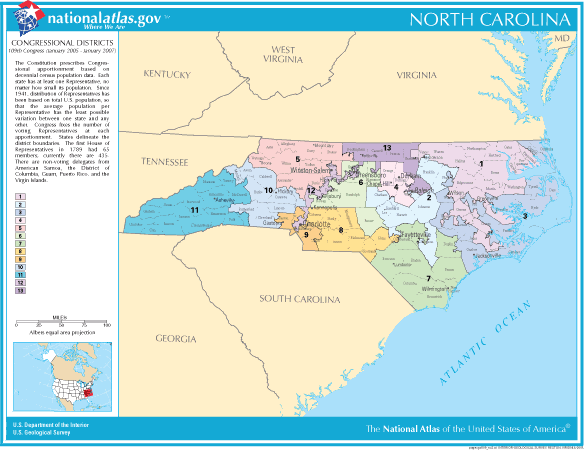
North Carolina is sandwiched between two states – Virginia and South Carolina – where Obama racked up impressive victories over Clinton (by 29% and 28%, respectively). It has a large African-American voting population, which will certainly help to contribute to Obama’s margin of victory. Given that at least 38% of registered Democrats are African-American, it’s almost a certainty that he will win the state in double digits, at the very least. Obama boasts the backing of 3 of North Carolina’s 7 Democratic House representatives – G.K. Butterfield (CD-01), David Price (CD-04), and Mel Watt (CD-12) – all of whom come from districts where Obama is sure to perform strongly. He also has been endorsed by a bevy of former backers of John Edwards, including Edwards’ national campaign chairman, Ed Turlington. Both major Democratic candidates running to replace outgoing Democratic Gov. Mike Easley, Lt. Gov. Bev Purdue and State Treasurer Richard Moore, have also endorsed Obama.
While it is an uphill climb for Clinton to avoid getting blown out in the state, she did receive the endorsement of Easley this morning, which will provide her with a boost. Bill Clinton has also been touring the rural areas of the state extensively, doing up to 7 events a day in support of his wife (who’s running for president again?). This will probably help to drive up Clinton’s percentage of the vote in areas that probably weren’t going to tilt towards Obama to begin with. Still, it’s unlikely to help Clinton overcome the difficulties of winning a primary where a demographic that will make up at least a third of the voting population (African-Americans) will vote for Obama in overwhelming numbers.
NC CD-01: 6 delegates
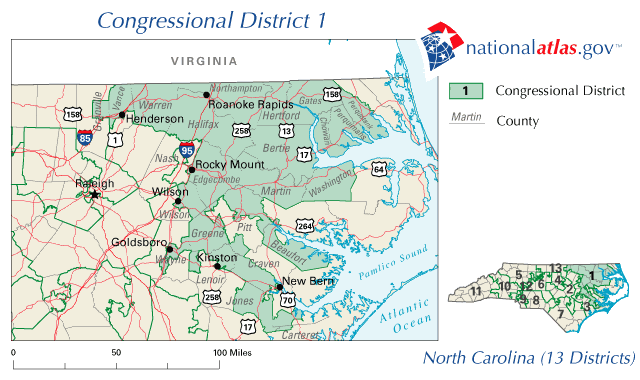
This is a majority-minority district (it is 50.7% African-American) in the northeast corner of the state that borders Virginia and stretches (in a gerrymandered fashion) down the coastline. Unfortunately for Obama, this district has an even number of delegates (6 pledged delegates) that will make it exceedingly difficult to take away a lot of delegates from the district. He would need 75% to earn a 5-1 split, which makes this unlikely. Obama won 73% in the neighboring district in Virginia (CD-04), but he did manage to get more than 75% of the vote in many of the Virginia counties that border the district – even though it has less African-Americans. That being said, the district is more rural, and with the lowest median income in the state, the white voters are likely to split heavily in Clinton’s direction. Obama should definitely surpass the 58.5% to get a 4-2 split, though.
Allocation of CD-01 delegates
Barack Obama: 4 pledged delegates
Hillary Clinton: 2 pledged delegates
NC CD-02: 6 delegates
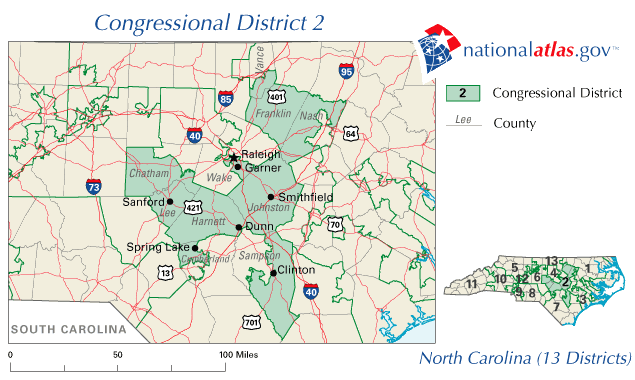
Another district that is effectively split between rural and urban areas, there is still a sizable African-American population (30.4%), which may be enough for Obama to win a majority of the votes in the district. However, it likely won’t be enough to vault him over the 58.5% barrier to net an extra delegate. With a median income under the state average, he would need a boost from working-class white voters – which isn’t likely to happen.
Allocation of CD-02 delegates
Barack Obama: 3 pledged delegates
Hillary Clinton: 3 pledged delegates
NC CD-03: 4 delegates
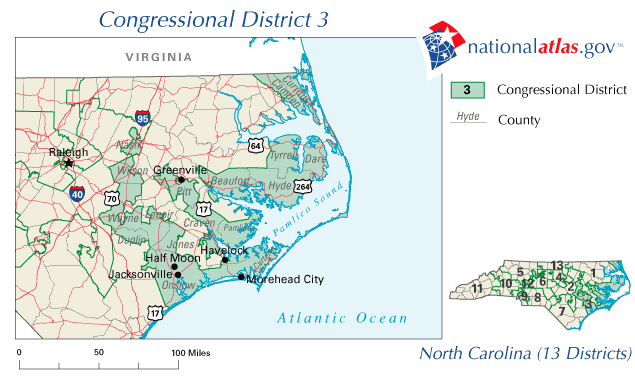
Another heavily gerrymandered district along the Atlantic coastline, it has a fairly scant African-American population (16.8%) in another district that has a relatively even split between urban and rural populations. It’s likely that neither candidate will earn the 62.5% needed to get the 3-1 split from this district, but if anyone were to have a shot, Clinton would definitely have the better shot. Obama has visited Greenville once, which is at the northern edge of the district.
Allocation of CD-03 delegates
Barack Obama: 2 pledged delegates
Hillary Clinton: 2 pledged delegates
NC CD-04: 9 delegates
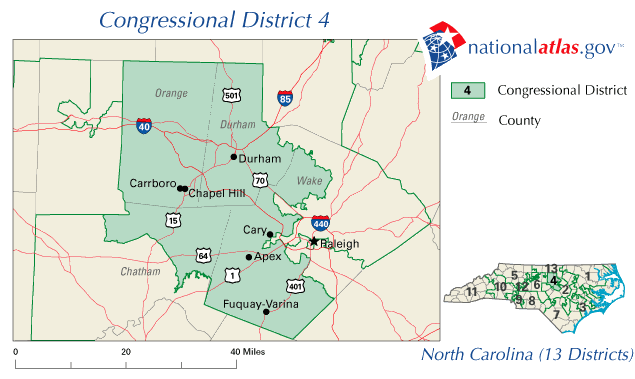
This district, which has the most delegates of any CD in North Carolina, once again plays to Obama’s strengths. It’s located in The Triangle, a highly educated and affluent region that contains the cities of Durham and Chapel Hill, along with the suburbs and exurbs of Raleigh. The median income is higher than the state average (almost $54,000, compared to the median of approximately $41,700 statewide), and it has two large universities (Duke and UNC-Chapel Hill) in the district. Its representative, David Price, has already endorsed Obama. While the district only has a 20.7% African-American population, the white voters in the district are wealthy and highly educated – a demographic that Obama will perform exceptionally well in. I doubt he will get the 72.22% needed to take 7 out of the 9 delegates, but clearing the 61.11% hurdle for a 6-3 split is virtually assured already.
Allocation of CD-04 delegates
Barack Obama: 6 pledged delegates
Hillary Clinton: 3 pledged delegates
NC CD-05: 5 delegates
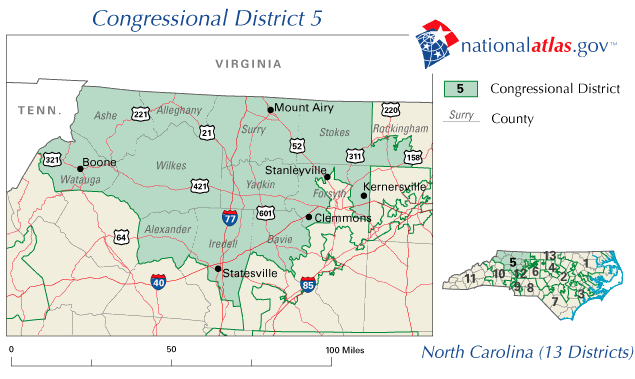
This district is towards the western portion of the state, which is the region where Clinton is likely to perform the best. It borders counties in Tennessee and Virginia where Clinton picked up close to 70% of the vote. White voters make up nearly 90% of the population, and in a district that is slightly below the median income and is on the outskirts of Appalachia, Clinton should perform particularly well here. However, I don’t think she will get the 70% needed for a 4-1 split at this time.
Allocation of CD-05 delegates
Hillary Clinton: 3 pledged delegates
Barack Obama: 2 pledged delegates
NC CD-06: 5 delegates
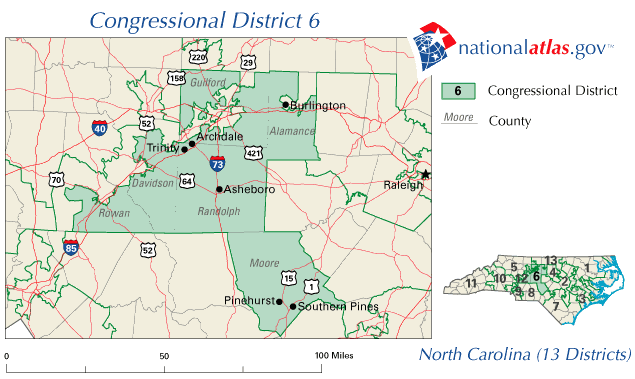
A district to the west of The Triangle, it is similar to CD-05 in that it is predominantly white (87.6% of the population), but it tends more to the middle class than the working class (the median income is slightly higher than the state average). It’s another district that is split between urban and rural areas. Clinton should be favored to net out the extra delegate, but she won’t get anywhere near 70% of the vote.
Allocation of CD-06 delegates
Hillary Clinton: 3 pledged delegates
Barack Obama: 2 pledged delegates
NC CD-07: 6 delegates

In the counties bordering this district in South Carolina, Obama generally performed well, although his performance in the most populous bordering county (Horry) was the only one he lost to Clinton (39-33). With a 23.2% African-American population, it’s possible that Obama can pull out a majority of the vote. That being said, I don’t think either candidate will break the 58.5% barrier for a 4-2 split.
Allocation of CD-07 delegates
Barack Obama: 3 pledged delegates
Hillary Clinton: 3 pledged delegates
NC CD-08: 5 delegates
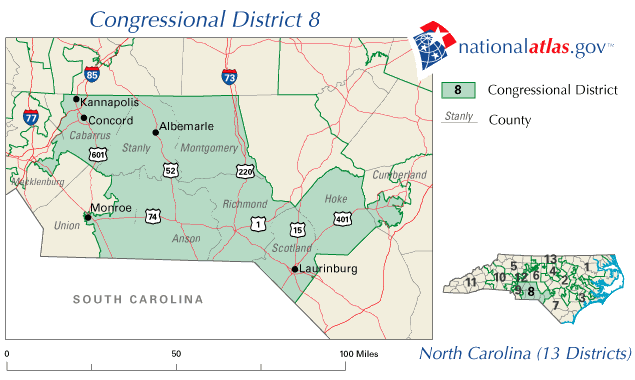
Obama is likely to net the extra delegate out of this district, given his strong performance in the South Carolina counties bordering the district. They make up a part of CD-05 in South Carolina, where Obama won a solid majority (55%) of the votes. With a 26.8% African-American population, it’s likely that Obama will pull a majority from the district, particularly given that about 69.4% of the district lies in urban areas. If Obama is the nominee, it could very well help put Larry Kissell over the top in his rematch against incumbent Republican Rep. Robin Hayes.
Allocation of CD-08 delegates
Barack Obama: 3 pledged delegates
Hillary Clinton: 2 pledged delegates
NC CD-09: 6 delegates

This also borders South Carolina’s CD-05, where Obama performed fairly well. There are two opposing demographic factors, though: first, the district is much ‘whiter’ than CD-08 or its South Carolinian counterpart. However, it also is clearly an upper-class district (the median income is higher than that in The Triangle), which would seem to favor Obama. I’m going to call it even and say they will split the delegates, although I would give Clinton better odds at reaching 58.5% and getting 4 delegates from the district.
Allocation of CD-09 delegates
Barack Obama: 3 pledged delegates
Hillary Clinton: 3 pledged delegates
NC CD-10: 5 delegates

This is unfriendly territory for Obama; with a small black population and a district that borders on Appalachia territory, Clinton is going to perform well here. It’s home to the odious Republican Rep. Patrick McHenry, and it’s one of the most conservative districts in the state. Given the tendency for conservative voters to go for Clinton in more recent primaries, it’s safe to say Clinton will net the extra delegate here. Obama should be able to surface above 30% to maintain the 3-2 split, but it’s not out of the question that it may not happen.
Allocation of CD-10 delegates
Hillary Clinton: 3 pledged delegates
Barack Obama: 2 pledged delegates
NC CD-11: 6 delegates
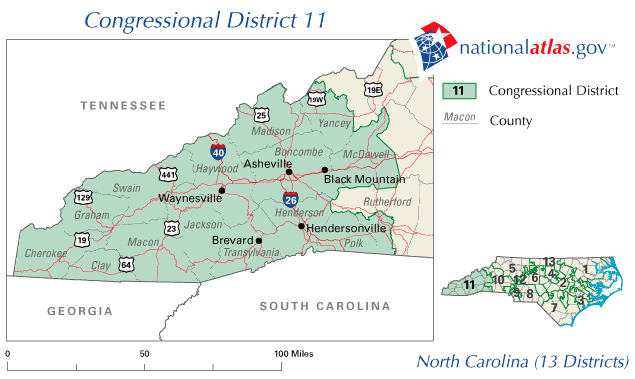
Home to the very conservative Democratic Rep. Heath Shuler, this is a district that would be a bloodbath except for the presence of Asheville, a liberal oasis that voted for (wait for it) Dennis Kucinich in the 2004 primaries. The rest of the district is likely to vote heavily for Clinton. However, she needs 75% to earn a 5-1 split, and given that the Asheville metro region will probably have 35-40% of the Democratic primary votes, it won’t happen. I still fully expect Clinton to break 58.5% and get a majority of the delegates, though.
Allocation of CD-11 delegates
Hillary Clinton: 4 pledged delegates
Barack Obama: 2 pledged delegates
NC CD-12: 7 delegates
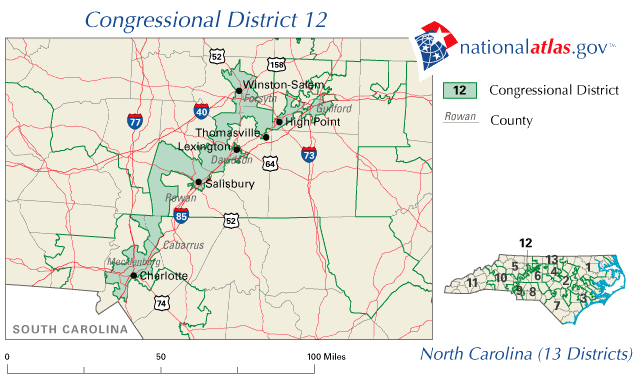
This heavily gerrymandered district, represented by Obama backer Rep. Mel Watt, stretches from Charlotte in the south to Winston-Salem in the north. An urbanized district with almost a 45% African-American population, Obama is going to win this district big. He should have no trouble reaching the 64.3% needed to get a 5-2 split of the delegates.
Allocation of CD-12 delegates
Barack Obama: 5 pledged delegates
Hillary Clinton: 2 pledged delegates
NC CD-13: 7 delegates
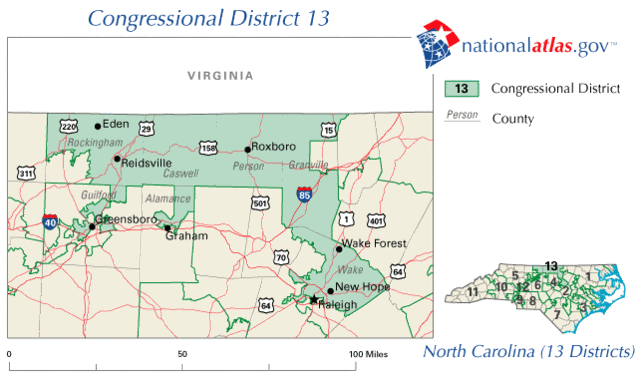
This district, represented by netroots favorite Rep. Brad Miller, was newly-created after the 2000 census gave North Carolina another congressional seat. With the district being solidly middle-class and with a 27.1% African-American population, Obama should be favored to net out the extra delegate. It includes the major urban centers of Greensboro and Raleigh and encircles The Triangle (which, as aforementioned, will go heavily for Obama). That being said, Obama will likely fall well short of the 64.3% needed for 5 delegates.
Allocation of CD-13 delegates
Barack Obama: 4 pledged delegates
Hillary Clinton: 3 pledged delegates
At-Large Delegates (26 delegates) and Pledged PLEO Delegates (12 delegates)
The latest polling averages show Obama with a 16% margin or so on Clinton, although there are a fair number of undecideds. The important thing to note is that Obama has been above 50 in every poll (except for the latest SUSA, which I believe is an outlier), while Clinton fails to break 40 (except, again, in SUSA). Given that Obama cleaned Clinton’s clock in the two states to the north (Virginia, by a 64-35 margin) and the south (South Carolina, by a 55-27-18 margin), he should be expected to do reasonably well. Clinton will perform better because she has been paying attention to North Carolina more than either of those states, but she is still looking at a shellacking in the popular vote. As of now, I’ll give Obama a 16% margin of victory, 58-42. The delegate split is as follows:
Allocation of at-large delegates
Barack Obama: 15 pledged delegates
Hillary Clinton: 11 pledged delegatesAllocation of pledged PLEO delegates
Barack Obama: 7 pledged delegates
Hillary Clinton: 5 pledged delegates
Conclusion
For now, I forecast Barack Obama to come away from the North Carolina primary with 63 pledged delegates, compared to a haul of 52 pledged delegates for Hillary Clinton. This will wind up virtually erasing Clinton’s advantage from her Pennsylvania victory (where she will net out either 10 or 12 delegates, depending on the final reported results from Pennsylvania’s CD-07). If Clinton picks up 6 delegates from Indiana, as I had previously predicted, Obama will net out 5 delegates for the day – thus extending his lead in the pledged delegate count to 166 pledged delegates (based on his website’s delegate counter). With only 217 pledged delegates in the contests remaining afterwards, Obama will be guaranteed to come out ahead in the pledged delegate count. This victory in North Carolina – regardless of the outcome in Indiana – will likely be the final nail in the coffin for the Clinton campaign.
Before I address the best- and worst-case scenarios, I’d like to talk about SUSA’s latest poll of North Carolina. One reason I feel the results are off is the results from The Triangle. SUSA has Clinton up 9, which seems a bit absurd given the inherent strengths Obama has in the region. Compare it to the results of PPP’s latest poll, and it shows Obama leading by 21 in the area code (919) that makes up the region. While SUSA has a good record this primary season, PPP is based in North Carolina, and I am therefore more inclined to believe their results (after all, if they can’t poll their own state, what good are they?). All of the other polls in North Carolina (reasonably reliable ones like Rasmussen, along with unreliable ones such as ARG) are more in line with PPP’s numbers, so it’s likely that SUSA is using a different voting model that is generating outliers.
The last note is that both SUSA and PPP show early voters coming in heavily for Obama: SUSA has Obama winning those voters 57-39, while PPP has him up 63-31. While these are relatively minuscule numbers (they make up 2% of SUSA’s polling), it means that Obama could build up a pre-Election Day advantage that makes it difficult for Clinton to overcome (similar to what happened to Obama in California).
Best-case scenario for Obama
It’s possible that Obama could pull off a 4-2 split in CD-02 if his campaign can do stellar GOTV with the black vote. PPP’s polling shows Obama with a large lead in the 910 area code (southeast NC), which could mean he will get a 4-2 split in CD-07. If the campaign can also make sure he racks up large margins in Asheville, it is also possible (albeit highly unlikely) that he could force Clinton below the 58.5% threshold, making the district a 3-3 split. If he is able to run up the popular vote to margins closer to what he earned in Virginia (where he got 64%) as opposed to South Carolina (where he got 55%), he can pick up an extra at-large and pledged PLEO delegate. A victory of this magnitude (say, 63%-37%) would result in Obama netting out 21 delegates with a 68-47 margin.
Worst-case scenario for Obama
Clinton is going to lose this state, but the margins could close if Rush Limbaugh’s “Operation Chaos” voters, combined with the state GOP’s ad featuring Rev. Jeremiah Wright, take their toll on Obama in the next week. I don’t suspect it will have much effect, but it could help drive up Clinton’s numbers in districts favorable to her. If she can pull off 4-1 splits in CD-05 and CD-10 – which are in the western portion of the state – along with narrowing Obama’s vote in The Triangle such that he only wins by a 5-4 margin, it will halve Obama’s delegate lead. Throw in a narrowing of the popular vote margin to single digits (let’s say 54-46 Obama), and she picks up a delegate in both the at-large and pledged PLEO count. This would result in a 59-56 delegate split in favor of Obama – something that the press would be sure to spin as a loss, even if the overall delegate math is largely unaffected by what happens in these contests at this point.
Obama has spent a few days down in North Carolina, seeking to shore up his base of support. While both campaigns are fighting hard in this state, Obama is likely to win it. Given that his campaign has far more offices on the ground compared to Clinton, has been set up in-state for longer, and has favorable demographics, he’ll win the primary here – and it should effectively end Clinton’s realistic chances at the nomination. A blowout would help negate any negative effects of a potential loss in Indiana, and it would reinforce the math – which cannot be avoided – even more.
(Cross-posted from Daily Kos)




